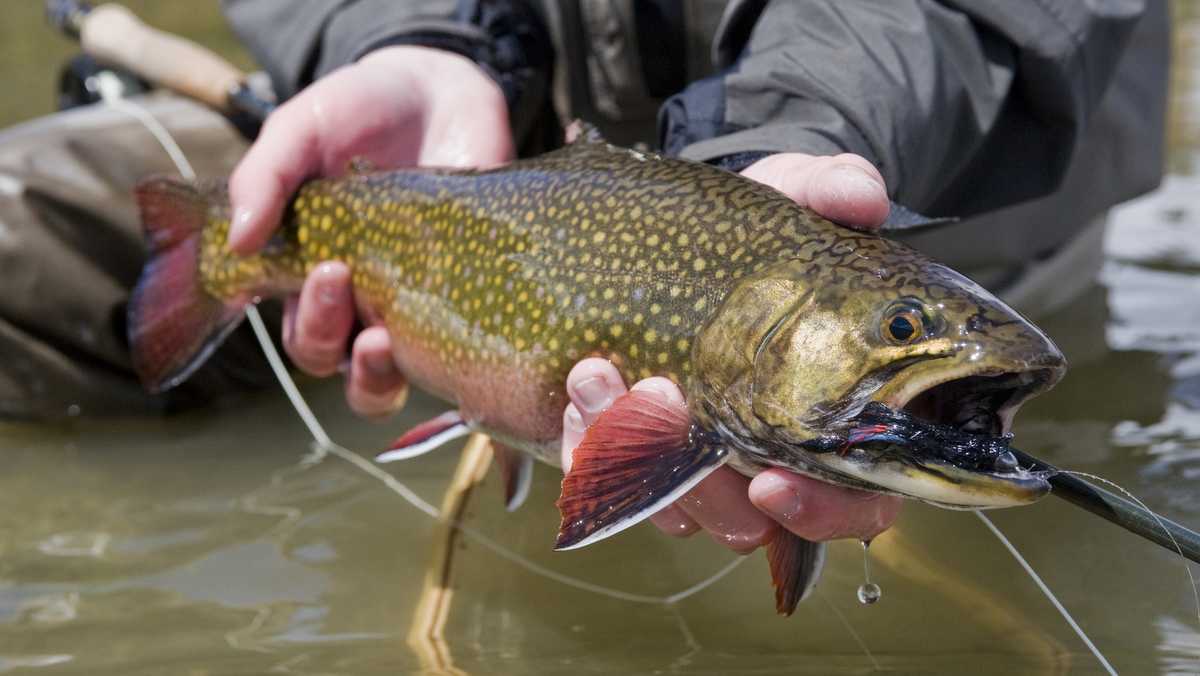
Pennsylvania's state fish is a freshwater favorite — the brook trout. The brook goes by several names locally, including brown trout, brookie and speckled trout.It is also the only native trout not only to Pennsylvania waters but those along the eastern seaboard.The brook trout officially became the Pennsylvania state fish in 1970. About the Brook TroutThe fish weighs in at an average of 52 grams (0.1 pounds) and an average length of 148 mm (5.8 inches).These fish have a dark base color decorated with pale pattern spots, as well as multiple gradients and spots decorating their scales. Notable details include:A dark olive base color.Pale pattern spots. The contrast indicates breeding vs nonbreeding. Scattered red spots haloed with blue.Color transition from olive-yellow to orange-red.A milky-white underside and jaw.Olive-yellow with black bars on the dorsal fin.Despite being called the brook trout, it is actually classified as a Char due to it having a dark body and light spots instead of a light body with dark spots that denote trout.It is also the state fish of several other East Coast states: New York, New Jersey, New Hampshire and Vermont to name a few.HabitatScientifically named the Salvelinus Fontinalis (meaning "living in springs"), its natural habitat is clean, cold water, mountain streams, typically covered in the shade of the forest canopy.They spend most of their time active in the dawn and dusk, descending into the deeper waters during the midday or into the shade if available.As the only native trout in its habitat, it fills in as the primary and dominant predatory fish, but it is also preyed upon by:Northern water snakesMinkKingfishersHeronsOccasionally ottersBrook trout are aggressive predators who will eat anything smaller than them, whether that be insects, terrestrial or aquatic invertebrate, other fish and vertebrate. They are also cautious and easy to scare, when sharing a habitat with rainbow and brown trout it will feed on more bottom-dwelling organisms.Reproduction & RearingStarting in mid-September through mid-November, the starting signal for the brook trout are shorter days, increased fall flows and temperature drops.Some studies show that brook trout might practice "Natal Homing," where they remember and return home to where they hatched in order to mate.Reaching maturity in one to two years, female brook trout dig nests known as redds where eggs are deposited, fertilized and covered in gravel, where they'll hatch anywhere between 30 to 165 days and vacate in search of territory shortly after.Although brook trout spawn many eggs, few survive until maturity.
Pennsylvania's state fish is a freshwater favorite — the brook trout.
The brook goes by several names locally, including brown trout, brookie and speckled trout.
It is also the only native trout not only to Pennsylvania waters but those along the eastern seaboard.
The brook trout officially became the Pennsylvania state fish in 1970.
About the Brook Trout
The fish weighs in at an average of 52 grams (0.1 pounds) and an average length of 148 mm (5.8 inches).
These fish have a dark base color decorated with pale pattern spots, as well as multiple gradients and spots decorating their scales. Notable details include:
- A dark olive base color.
- Pale pattern spots. The contrast indicates breeding vs nonbreeding.
- Scattered red spots haloed with blue.
- Color transition from olive-yellow to orange-red.
- A milky-white underside and jaw.
- Olive-yellow with black bars on the dorsal fin.
Despite being called the brook trout, it is actually classified as a Char due to it having a dark body and light spots instead of a light body with dark spots that denote trout.
It is also the state fish of several other East Coast states: New York, New Jersey, New Hampshire and Vermont to name a few.
Habitat
Scientifically named the Salvelinus Fontinalis (meaning "living in springs"), its natural habitat is clean, cold water, mountain streams, typically covered in the shade of the forest canopy.
They spend most of their time active in the dawn and dusk, descending into the deeper waters during the midday or into the shade if available.
As the only native trout in its habitat, it fills in as the primary and dominant predatory fish, but it is also preyed upon by:
- Northern water snakes
- Mink
- Kingfishers
- Herons
- Occasionally otters
Brook trout are aggressive predators who will eat anything smaller than them, whether that be insects, terrestrial or aquatic invertebrate, other fish and vertebrate. They are also cautious and easy to scare, when sharing a habitat with rainbow and brown trout it will feed on more bottom-dwelling organisms.
Reproduction & Rearing
Starting in mid-September through mid-November, the starting signal for the brook trout are shorter days, increased fall flows and temperature drops.
Some studies show that brook trout might practice "Natal Homing," where they remember and return home to where they hatched in order to mate.
Reaching maturity in one to two years, female brook trout dig nests known as redds where eggs are deposited, fertilized and covered in gravel, where they'll hatch anywhere between 30 to 165 days and vacate in search of territory shortly after.
Although brook trout spawn many eggs, few survive until maturity.
"fish" - Google News
May 21, 2024 at 09:43PM
https://ift.tt/t0ZcXyM
PA State Fish Fun Facts - the brook trout - WGAL Susquehanna Valley Pa.
"fish" - Google News
https://ift.tt/JmriKDV
https://ift.tt/qjwkJPd
Bagikan Berita Ini















0 Response to "PA State Fish Fun Facts - the brook trout - WGAL Susquehanna Valley Pa."
Post a Comment